If there’s one thing I always forget to do before I cruise, it’s to stop at the ATM. Cruises largely operate on a cashless system, so traveling without cash is not a big deal. You attach a credit card to your onboard account and use your keycard to make purchases on board.
But sometimes you need dollar bills or foreign currency. Fortunately, in those situations, you can find ways to get cash on most cruise ships.
Occasionally, I need a few U.S. dollars to tip a porter, a tour guide or the person who delivers my room service, and I always leave an extra cash tip for my room steward, beyond the auto-gratuities. Plus, in certain destinations abroad, vendors only accept cash in local currency. If you’re hoping to shop when you’re in port, you’ll want to have some cash handy.

The best time to get cash is before you leave home, either from an ATM (if you need U.S. dollars) or from your local bank, which can almost always obtain foreign currency on your behalf at a better rate than you’d find at an airport currency exchange counter. Local ATMs in foreign countries are also a solid option; complete the transaction in local currency instead of U.S. dollars to avoid bad exchange rates.
But, if — like me — you happen to forget or run out of time in your rush to make it to the airport, you can still get cash after boarding your cruise ship.
At an onboard ATM

Many large cruise ships have ATMs on board, and they’re the quickest and easiest way to grab cash while you’re sailing. The biggest drawback is that they often charge exorbitant fees — upward of $10 per transaction. If you must withdraw cash, calculate how much you’ll need for the entire voyage so you only need to make one withdrawal.
At the front desk
If you’re on a ship that doesn’t have an ATM, ask the front desk if they can give you cash and charge the amount to your onboard bill. In most cases, the transaction will post as a credit card purchase rather than a cash advance, so you won’t have to worry about additional charges from your card issuer or bank. Be sure to double-check with guest services if you’re concerned.
This is only an option on certain ships, so don’t count on every cruise ship offering cash at the front desk.
At the casino
Another option for finding cash on a cruise is the onboard casino if your vessel has one. (And, no, I’m not talking about gambling with the intention of winning to obtain money.)
Head to the cashier and ask to preload the money you need onto your keycard, or have it given to you in chips, depending on how your ship handles gaming. Find the least expensive slot machine or table game, play the smallest amount of credits, and when you’re finished, go back to the desk to cash out.
Because you’re likely to lose the amount you play in the slot machine, this is a tactic you should only use in a pinch.
Bottom line
Although cruising is a largely cashless endeavor, you might need paper money in certain circumstances. It’s ideal to take cash out from your bank or a no-fee ATM before you head to your embarkation port, but that’s not always possible. If you need cash for tips or purchases ashore, these options might work for you in a pinch if you don’t mind potential fees and other charges.
Learn more about cruising with these TPG resources:
- Packing for a cruise? These items aren’t allowed on board
- Man overboard: Cruise ship overboards and how they happen
- What is baked Alaska, and why is it paraded around cruise ships?
- What are the largest cruise ships in the world?
- What is the Jones Act, and how does it affect cruise ships?
- What is a lido deck on a cruise ship?
- What’s a cruise cabin guarantee — and will it save you money?
- What’s the difference between a cruise ship concierge and a butler?




